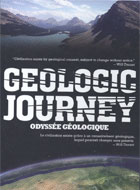
Geologic Journey 2007
Distributed by National Film Board of Canada, 1123 Broadway, Suite 307, New York, NY 10010; 800-542-2164
Produced by CBC (Canadian Broadcasting Corporation) Home Video with SRC (Société Radio-Canada), Discovery Science, Altau/TuttiFrutti, and Office National de Film
Directed by Michael Allder
DVD, color, 260 min. total; each episode is approx. 52 min.
General Adult
Canadian Studies, Geography, Science
Date Entered: 02/11/2011
Reviewed by Erin O'Toole, Science and Technology Librarian, University of North Texas, DentonGeologic Journey is a five-episode story of how plate tectonics created major landforms in Canada during the span of 500 to 200 million years ago, and how geologists uncover that story in the rocks we see today. The story is told mainly by David Suzuki, who narrates the explorations of geologists as they travel from the Northwest Territories to the southern United States and even to Morocco to trace Canada’s prehistory. His narration is punctuated by explanations from excited geologists as they point out an intriguing swirl or crystal in a rock. Lay people also discuss their relationship with the North American geography: a mountain scout for hunters, a Native American storyteller, an artist, amateur rock and fossil hunters, and coal and salt miners.
Visually, the bulk of the series is composed of scenic footage of testaments to the geologic upheaval in Canada’s past: Niagara Falls, Georgian Bay, Willmore Wilderness Park, Vancouver Island, the Torngat Mountains, and the Tablelands of Gros Morne National Park, to name a few. The flyovers of mountains and coasts are lengthy, and are the main reason this series is best-suited to a general audience. The actual educational material in the episodes only takes up approximately 50-60% of the time in each section.
The series uses three-dimensional, computer generated animation to demonstrate the mechanics of plate tectonics. The same globe is used in each episode, and the same footage of plate movement is shown each time. The plates are not labeled and move quickly, so it is difficult for the viewer to actually learn names and movements of individual continental and oceanic plates. Occasionally, cross-sections of terrain are shown to explain how lava, liquefied sand, or minerals rose from the mantle to the earth’s surface. In attempt to make the cross-section look “natural,” detail and comprehension that a diagram would provide are lost.
Geologic Journey is a good choice for public libraries, where patrons might want a basic introduction to plate tectonics, but mainly want to see the beauty and majesty of Canada. The series could definitely inspire a viewer to investigate geology further, but the viewer is not going to gain a solid foundation of the concepts and terminology of plate tectonics. Anyone looking for that type of information will end up on the computer afterwards looking for location names and geological terms like I did.